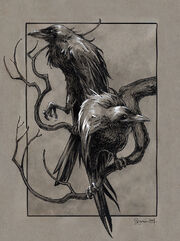
In Norse mythology, Huginn (Old Norse: [ˈhuɣenː]; "thought") and Muninn (O.N.: [ˈmunenː]; "memory" or "mind") are a pair of ravens that fly all over the world, Miðgarðr, and bring information to the god Óðinn. Huginn and Muninn are attested in the Poetic Edda, compiled in the 13th century from earlier traditional sources: the Prose Edda and Heimskringla, written in the 13th century by Snorri Sturluson; in the Third Grammatical Treatise, compiled in the 13th century by Óláfr Þórðarson; and in the poetry of skalds. The names of the ravens are sometimes modernly anglicized as Hugin and Munin.
In the Poetic Edda, a disguised Óðinn expresses that he fears that they may not return from their daily flights. The Prose Edda explains that Óðinn is referred to as "raven-god" due to his association with Huginn and Muninn. In the Prose Edda and the Third Grammatical Treatise, the two ravens are described as perching on Óðinn's shoulders. Heimskringla details that Óðinn gave Huginn and Muninn the ability to speak.
Migration Period golden bracteates, Vendel-era helmet plates, a pair of identical Germanic Iron Age bird-shaped brooches, Viking Age objects depicting a moustached man wearing a helmet, and a portion of the 10th or 11th century Thorwald's Cross may depict Óðinn with one of the ravens. Huginn and Muninn's role as Óðinn's messengers has been linked to shamanic practices, the Norse raven banner, general raven symbolism among the Germanic peoples, and the Norse concepts of the fylgja and the hamingja.




